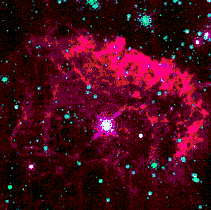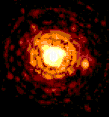
A star remains on the main sequence for most of its life during which changes occur very slowly. The star gets its energy almost entirely from the thermonuclear reaction of hydrogen to helium. Our closest star, the sun, is a main sequence star. | ||

It has been found that there is a direct relationship between a stars position on the main sequence and its mass. That fact that some stars do not lie on the main sequence suggests that these stars must be at a different stage in their life span and there energy source is different to those on the main sequence. Stars in the lower end of the main sequence have a mass barely great enough to stop gravitational contraction. This critical mass is about one twelveth of the suns mass. In the upper end of the main sequence the critical mass is about 100 more than our sun. When all hydrogen in the central part of a star has been used up, a core develops that contains only helium (and some heavier elements). Since there is no longer a supply of Hydrogen to supply heat, the core begins to contract gravitationally and the star's structure changes and the star leaves the main sequence. | ||

The lifetime of a star depends on two things; how much fuel it has and how fast it uses it up. We know that hydrogen is the main fuel source and that most of a stars mass consists of hydrogen. This means that the amount of fuel is proportional to the total mass of the star. The most massive stars have the shortest lifetimes. Because they have most fuel, they burn it so prodigously that their lieftimes are very short. A stars time on the main sequence varies from a few million to 2*1011 yrs. As we will see later the way in which a star evolve depends on its mass. | ||
|
Last modified 9th August 1999 Sarah Amandusson www_astro@mssl.ucl.ac.uk | ||